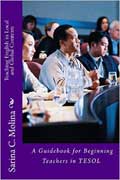May 2015 – Volume 19, Number 1
Teaching English in Local and Global Contexts:
|
|||
| Author: | Sarina Chugani Molina (2014) |  |
|
| Publisher: | CreateSpace Independent Publishing Platform | ||
| Pages | ISBN-13 | Price | |
|---|---|---|---|
| 81 pages | 9781495288753 | $19.00 USD | |
Sarina Chugani Molina’ Teaching English in Local and Global Contexts is a concise, deeply personal, and potentially helpful guidebook for new U.S.-based teachers of English to Speakers of Other Languages looking to teach outside the U.S. As such, the book provides aspiring teaching professionals an 81- page glimpse of the complexity of teaching “overseas” and the need for such teachers to enter international teaching with awareness of and sensitivity to the often-challenging non-pedagogical situations they encounter in “foreign” lands. The book concludes with guiding principles broadly adaptable across content areas in global as well as local contexts.
Chapter 1 draws from the author’s own personal lived experience to suggest the need for authentically caring professionals willing to guide students through teaching and learning grounded in humanizing pedagogies. Relationships matter and new professionals need to build these with their students sand colleagues. Chapter Two highlights common cross-cultural misunderstandings and frustrations that expatriate teachers of English encounter. However, Chagani Molina argues that educators who are guests in a foreign land should not attempt to change the way the English is taught in a host country. Rather, they should consider with great respect the local, national, and regional traditions and parameters for teaching and learning. Chapter 3 unpacks multiple theoretical approaches of language learning to argue in favor of a holistic approach per individuals’ teaching philosophies that consider learners’ needs, styles, purposes, cultures, and traditions. To achieve this, the author suggests that educators should ask and re-ask themselves questions: Who are my students? What is my philosophy in teaching and learning language? What is my role? And what are the needs, goals, and aspirations of my students?
Chapter Four provides a thumbnail of the various methodologies that have shaped the discipline with an emphasis on a communicative approach. Here the author suggests that instead of opting for the most popular method of the time, teachers might focus on needs and goals of students and decide the strategy based on these unique classroom equations. Chapter 5 offers an overview of the skills of reading, writing, listening, and speaking Diversity in terms of proficiency levels and integrated skills will be a challenge in every classroom but can be addressed by carefully developed lessons where the learners’ needs are given utmost importance. Teaching of reading, writing, speaking and, listening a language is presented with explanation on post, pre and, during stages of activities. Chapter 6 narrates personal anecdotes surrounding four teachers with origins and degrees from within and outside of United States who taught in many Asian countries. This chapter is a must read for any beginning or potential expatriate teacher with its emphasis on non-pedagogical factors such as, signing contracts without reading the fine prints, presuming the housing is included in those contracts, and/or taking a position with the idea that he/she will be able to travel around leisurely on holidays. The unpredictability of such non-pedagogical factors can adversely shape educators’ experiences teaching, learning, and living in a new environment.
Finally, Chapter 7 presents seven guiding principles for teaching practices. These principles include: Understanding, Purpose, Connections, Engagement, Application, Assessment, and Reflection. The author grounds each guiding principle in questions such as, What background knowledge and experiences your students already have regarding upcoming topic? What opportunities will you provide to your students to apply their knowledge to other situations or contexts; and, What forms of assessments are you using to document their learning of the objectives? These questions within each guiding principle are valuable for educators across the disciplines as they can generate critical reflection among teachers about their practices and styles of teaching, engaging, challenging, assessing, and supporting pupils in acquiring English language proficiency. The author reminds readers to stay focused one their students’ personal journeys. A brief but important read, Teaching English in Local and Global Contexts: A guidebook for beginning teachers in TESOL is a starting point for new or potential expatriate teachers of English as a Foreign Language.
Reviewed by
Kruti Dave
The University of North Carolina at Charlotte
<kdave3![]() uncc.edu>
uncc.edu>
| © Copyright rests with authors. Please cite TESL-EJ appropriately.
Editor’s Note: The HTML version contains no page numbers. Please use the PDF version of this article for citations. |

